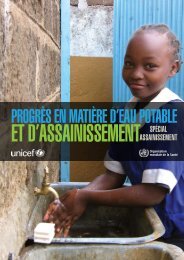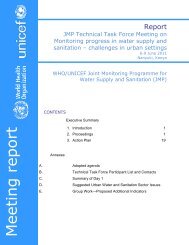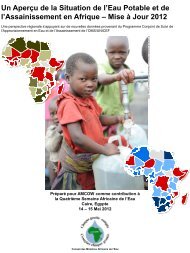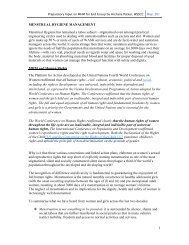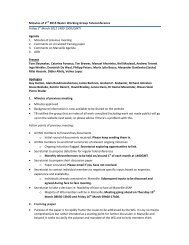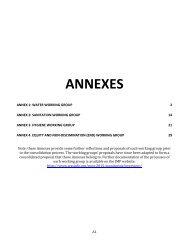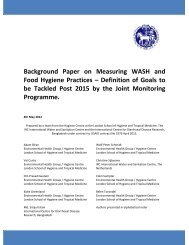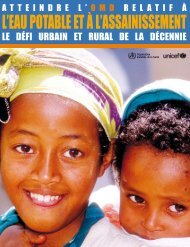rapid assessment of drinking-water quality in the republic of tajikistan
rapid assessment of drinking-water quality in the republic of tajikistan
rapid assessment of drinking-water quality in the republic of tajikistan
You also want an ePaper? Increase the reach of your titles
YUMPU automatically turns print PDFs into web optimized ePapers that Google loves.
Table 2.1<br />
RADWQ parameters and <strong>in</strong>spections<br />
Microbiological and related<br />
parameters<br />
Thermotolerant coliforms<br />
Faecal streptococci<br />
Turbidity<br />
pH<br />
Residual chlor<strong>in</strong>e<br />
Physical and chemical<br />
parameters<br />
Appearance<br />
Conductivity<br />
Nitrate<br />
Iron<br />
Arsenic<br />
Fluoride<br />
Copper<br />
Inspections<br />
Sanitary <strong>in</strong>spection<br />
<br />
<br />
<br />
<br />
<br />
Database. Data on <strong>water</strong> supply coverage and technology were available at three adm<strong>in</strong>istrative<br />
levels (i.e. national, regional and district level), as required by <strong>the</strong> methodology (see alsoTable<br />
1.2). Additionally, a detailed rayon <strong>in</strong>ventory <strong>of</strong> <strong>in</strong>dividual utility piped supplies was available,<br />
which <strong>in</strong>cluded <strong>in</strong>formation about <strong>the</strong> serv<strong>in</strong>g capacity and work<strong>in</strong>g condition <strong>of</strong> <strong>in</strong>dividual <strong>water</strong><br />
supplies (Annex 2). The database allowed an exact calculation <strong>of</strong> supply zones.<br />
Criteria for <strong>in</strong>clud<strong>in</strong>g a <strong>water</strong> supply <strong>in</strong> <strong>the</strong> survey. The cut-<strong>of</strong>f size for supplies to be <strong>in</strong>cluded <strong>in</strong><br />
<strong>the</strong> survey was set at a serv<strong>in</strong>g capacity <strong>of</strong> 500 people. Also, even though <strong>the</strong> utility piped<br />
supplies <strong>in</strong> Tajikistan are subdivided <strong>in</strong>to four categories, only three <strong>of</strong> <strong>the</strong> categories were<br />
<strong>in</strong>cluded <strong>in</strong> <strong>the</strong> survey. The fourth supply category was judged not to be a primary source <strong>of</strong><br />
<strong>dr<strong>in</strong>k<strong>in</strong>g</strong>-<strong>water</strong> and <strong>the</strong>refore was not relevant for <strong>the</strong> RADWQ project. The <strong>in</strong>cluded categories<br />
<strong>of</strong> <strong>water</strong> supply were: municipal/communal supplies; kolkhoz supplies, which serve <strong>the</strong> rural<br />
population; and supplies serv<strong>in</strong>g <strong>in</strong>dividual hospitals, k<strong>in</strong>dergartens or schools. The fourth<br />
category, supplies serv<strong>in</strong>g workers at <strong>in</strong>dividual comb<strong>in</strong>es or <strong>in</strong>dustries, was not <strong>in</strong>cluded.<br />
Primary stratification. At <strong>the</strong> national level, utility piped supplies and spr<strong>in</strong>gs serve more than<br />
5% <strong>of</strong> <strong>the</strong> population 1 (Table 1.2). O<strong>the</strong>r improved technologies (accord<strong>in</strong>g to JMP def<strong>in</strong>itions)<br />
serve less than 5% <strong>of</strong> <strong>the</strong> population. In contrast, it is estimated that ca. 42% <strong>of</strong> <strong>the</strong> total<br />
population uses <strong>water</strong> from open sources (i.e. rivers, channels, irrigation canals) for domestic<br />
purposes (see also Section 1.2). It was decided to <strong>in</strong>clude <strong>in</strong> <strong>the</strong> survey only <strong>water</strong> supplies that<br />
served more than 5% <strong>of</strong> <strong>the</strong> national population. The option <strong>of</strong> apply<strong>in</strong>g <strong>the</strong> 5% criterion to <strong>the</strong><br />
oblast, ra<strong>the</strong>r than national, level was discussed but rejected. Follow<strong>in</strong>g that option would have<br />
meant that transported <strong>water</strong> would have be <strong>in</strong>cluded <strong>in</strong> <strong>the</strong> oblast <strong>of</strong> GBAO, and dug wells<br />
<strong>in</strong>cluded <strong>in</strong> <strong>the</strong> oblast <strong>of</strong> Khatlon. The data would <strong>the</strong>refore have better represented <strong>the</strong> primary<br />
source <strong>of</strong> <strong>dr<strong>in</strong>k<strong>in</strong>g</strong>-<strong>water</strong> <strong>of</strong> <strong>the</strong> rural population <strong>in</strong> <strong>the</strong>se regions.<br />
Secondary stratification. The oblast adm<strong>in</strong>istrative level was selected as <strong>the</strong> broad area category.<br />
It is <strong>the</strong> most accepted broad division with<strong>in</strong> <strong>the</strong> country, and <strong>the</strong> oblasts divide <strong>the</strong> country <strong>in</strong>to<br />
geographical categories (e.g. mounta<strong>in</strong>ous and flatland areas). An overview <strong>of</strong> <strong>the</strong> broad areas<br />
selected is given <strong>in</strong> Figure 2.3.<br />
Sampl<strong>in</strong>g units. Rayons were chosen as <strong>the</strong> sampl<strong>in</strong>g unit category from which <strong>the</strong> clusters were<br />
to be selected, because rayon data on <strong>the</strong> served population were available. Towns that<br />
represented an <strong>in</strong>dependent adm<strong>in</strong>istrative unit were annexed to <strong>the</strong> overly<strong>in</strong>g rayons, with <strong>the</strong><br />
exception <strong>of</strong> <strong>the</strong> city <strong>of</strong> Dushanbe, which was treated as an <strong>in</strong>dependent sampl<strong>in</strong>g unit. The<br />
selection <strong>of</strong> sampl<strong>in</strong>g units or rayons to be <strong>in</strong>cluded <strong>in</strong> <strong>the</strong> survey used proportional weight<strong>in</strong>g<br />
tables, as suggested by <strong>the</strong> RADWQ methodology (see Annex 4 for a list <strong>of</strong> selected rayons).<br />
1 Even though national figures for spr<strong>in</strong>gs do not differentiate between protected and non-protected sources, all<br />
spr<strong>in</strong>gs were <strong>in</strong>cluded <strong>in</strong> this study as a way to verify <strong>the</strong>ir level <strong>of</strong> protection.<br />
10



